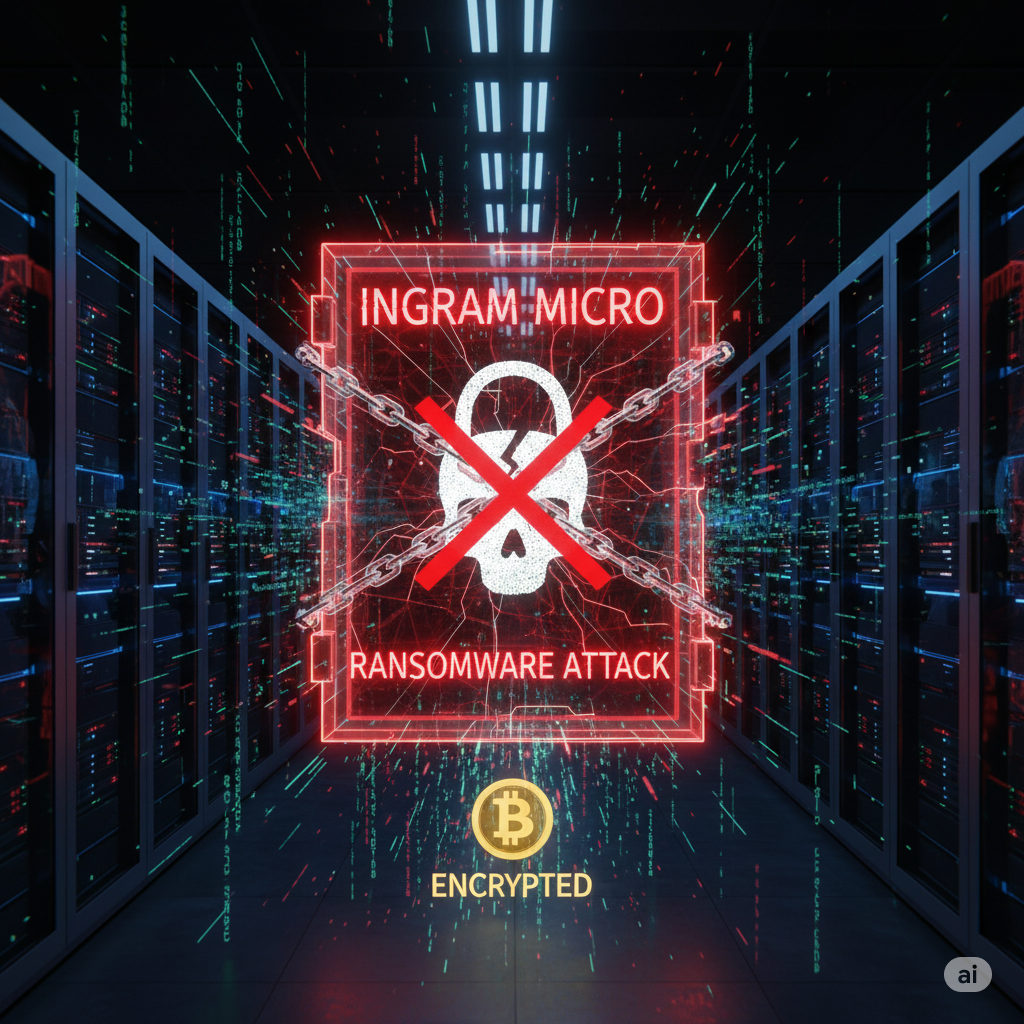The Ingram Micro ransomware attack in July 2025 shook the global IT distribution world. As one of the largest technology distributors, Ingram Micro powers supply chains for thousands of partners, resellers, and enterprises. When its systems went offline, the ripple effects were immediate – customers couldn’t place or track orders, licensing platforms went dark, and critical supply processes stalled.
This article breaks down what happened, how the attack unfolded, and what lessons businesses can take from the incident.
A Timeline of the Ingram Micro Ransomware Attack
- Early July 2025: Employees reported outages in ordering and licensing systems.
- July 5, 2025: Ingram Micro confirmed a cybersecurity incident, identified as a ransomware attack, and took systems offline to contain it.
- Following days: Customers worldwide were unable to access the Xvantage platform and other key tools.
- Within a week: Ingram Micro began restoring services, working with law enforcement and third-party forensic experts.
The Ingram Micro ransomware attack demonstrated how a single breach in a core distributor can impact the wider tech ecosystem.
The Technical Structure of the Malware
The ransomware used in the Ingram Micro ransomware attack followed the architecture common to advanced malware families but with custom enhancements for scale and stealth. At its core, the malicious program was composed of several tightly integrated modules, each with a distinct role in the attack chain:
- Loader/Dropper Module: This lightweight component was the first to execute once access was gained. Its purpose was to establish persistence, disable basic security controls, and deliver the main payload into memory.
- Privilege Escalation & Credential Harvester: Once the dropper executed, the next module attempted to obtain administrative privileges. It probed cached credentials, Kerberos tickets, and Active Directory tokens to allow lateral movement.
- Propagation Engine: Designed to spread across the enterprise, this module scanned the internal network for accessible machines, open shares, or weakly secured services. Its algorithms automated movement but also allowed manual operator input to guide attacks.
- Encryption Core: This was the heart of the ransomware. It systematically traversed file systems, encrypting documents with strong symmetric algorithms (AES-256) while securing decryption keys with asymmetric methods (RSA). By combining speed with cryptographic rigor, it ensured that recovery without the attacker’s key would be nearly impossible.
- Exfiltration & Command-and-Control Layer: Before encryption completed, the malware quietly packaged sensitive data and transmitted it to attacker-controlled servers. Communication was hidden inside encrypted HTTPS traffic, making detection harder.
- Ransom Note Generator: Finally, the malware left behind digital ransom notes on compromised systems. These notes contained payment instructions, deadlines, and threats of data leakage to pressure the victim into compliance.
This modular architecture shows why the Ingram Micro ransomware attack was so effective: each stage built upon the last, ensuring both disruption through encryption and leverage through data theft. It reflects how ransomware has evolved into a hybrid threat that mixes automation with human operator control.
Business Impact
This wasn’t just an IT outage. The Ingram Micro ransomware attack disrupted global supply chains, delaying shipments, halting transactions, and creating bottlenecks across industries. Customers, resellers, and vendors all felt the effect.
For Ingram Micro, the reputational hit was also significant. A ransomware breach at this scale raises questions about vendor security, supply chain resilience, and how prepared companies are for large-scale operational disruption.
Who Was Behind the Attack?
Reports linked the Ingram Micro ransomware attack to the ransomware group SafePay, known for double-extortion tactics. The group allegedly exfiltrated over 3.5 TB of data and threatened to leak it unless ransom demands were met.
Like many ransomware groups, SafePay didn’t just lock files – they also weaponized the threat of data exposure, forcing victims to weigh operational recovery against reputational and regulatory damage.
How the Malware Was Created and Operated
To understand the mechanics, it helps to look under the hood of how modern ransomware functions. In the case of the Ingram Micro ransomware attack, the malware was likely custom-built on a ransomware-as-a-service (RaaS) framework, giving attackers a ready-made toolkit.
- Initial Access – Attackers often gain entry through stolen VPN credentials, phishing emails, or exploiting unpatched vulnerabilities.
- Privilege Escalation – Once inside, the malware elevates its permissions, often using credential dumping tools.
- Propagation – The malicious code spreads laterally, moving from one system to another using Active Directory trusts or open ports.
- Encryption Engine – Files are encrypted with AES-256, while RSA keys lock the decryption process. Victims see ransom notes with instructions for payment.
- Exfiltration – Before encryption finishes, data is copied and exfiltrated to attacker-controlled servers – a hallmark of double extortion.
This two-pronged approach – encrypting systems while stealing data – maximizes leverage over victims. The Ingram Micro ransomware attack shows how sophisticated malware blends automation with manual operator control, making it extremely dangerous.
The Far-Reaching Impact of the Ransomware Attack
The disruption caused by the Ransomware Attack went far beyond a simple IT outage. It triggered significant delays in global supply chains, halting transactions and creating bottlenecks for thousands of resellers and vendors who rely on Ingram Micro’s services. For the company itself, the incident delivered a major blow to its reputation, raising critical questions about vendor security and the resilience of the modern tech ecosystem against sophisticated cyber threats.
Extending Protection to Modern Cloud Environments
One of the key lessons from large-scale breaches is that security can no longer focus solely on traditional servers and endpoints. As organizations migrate critical operations to the cloud, attackers are following suit. This raises the question, What Is a Cloud Workload and how do we protect it? A cloud workload-be it a virtual machine, a container, or a serverless function-represents a new and attractive target. Protecting these assets requires a different approach, emphasizing principles like Zero Trust and microsegmentation to prevent malware from spreading within cloud infrastructure, just as it does on-premises.
Lessons Learned from the Ingram Micro Ransomware Attack
The breach underscores key takeaways for any organization:
- Zero Trust Access: Don’t rely on VPNs alone; adopt Zero Trust Network Access (ZTNA) to verify identity and device health before granting access.
- Microsegmentation: Limit lateral movement by breaking the network into smaller, isolated zones.
- Immutable Backups: Ensure backups can’t be encrypted or deleted by attackers.
- Continuous Monitoring: Use User and Entity Behavior Analytics (UEBA) to detect unusual activity early.
- Third-Party Risk Management: As the Ingram Micro ransomware attack proved, supply chain partners can become single points of failure.
Why This Attack Matters
The Ingram Micro ransomware attack isn’t just another breach – it’s a wake-up call. It shows that critical distributors are prime targets and that ransomware is no longer only about encrypting files; it’s about shutting down global business operations.
The lesson is clear: organizations must prepare not just to defend against ransomware but to respond and recover quickly when it inevitably strikes.
Was Customer Data Exposed in the Ingram Micro Ransomware Attack?
Reports linked the incident to the SafePay ransomware group, which claimed to have exfiltrated more than 3.5 TB of sensitive information. While Ingram Micro has not confirmed the full scope of data exposure, the possibility of stolen files is real. This aligns with modern double-extortion tactics where attackers not only encrypt data but also steal it to increase pressure on victims. For customers, it raises concerns about proprietary information, contracts, and even personal data being at risk.
How Long Were Systems Down During the Ingram Micro Ransomware Attack?
The outage began in early July 2025 and lasted several days, with order management and licensing platforms like Xvantage offline. Ingram Micro began restoring operations within a week, prioritizing core systems to reduce disruption. While services were eventually brought back online, the downtime highlighted how a ransomware incident can instantly halt business continuity for both the company and its global partners.
What Systems Were Impacted by the Ingram Micro Ransomware Attack?
Key transactional systems were affected, including Xvantage, Impulse, and electronic data interchange (EDI) services. These platforms form the backbone of Ingram Micro’s global operations, allowing resellers and vendors to place and track orders, manage licenses, and integrate supply processes. Their unavailability showed how a single attack could ripple across the entire IT supply chain.
Who Was Responsible for the Ingram Micro Ransomware Attack?
The attack has been attributed to SafePay, a ransomware group known for double-extortion techniques. SafePay has built a reputation for targeting large enterprises and exfiltrating massive amounts of data before demanding payment. Their claim of stealing terabytes of information from Ingram Micro adds credibility to the attribution, though law enforcement investigations are ongoing.
How Did the Ingram Micro Ransomware Attack Likely Happen?
While forensic details have not been fully disclosed, experts believe the attackers may have gained access through stolen credentials, misconfigured remote access services, or unpatched vulnerabilities. Once inside, the malware spread laterally, escalated privileges, encrypted files, and exfiltrated data. This chain of events is consistent with how most modern ransomware attacks unfold.
What Steps Did Ingram Micro Take After the Ransomware Attack?
The company immediately took systems offline to contain the threat and prevent further spread. External cybersecurity specialists were engaged alongside law enforcement agencies to investigate and remediate the incident. Within days, Ingram Micro began restoring access to its critical platforms and worked to reassure customers and partners. Their response emphasized containment, recovery, and ongoing forensic analysis.
What Can Businesses Learn from the Ingram Micro Ransomware Attack?
The biggest lesson is the importance of resilience. Zero Trust Network Access, microsegmentation, immutable backups, and continuous monitoring can drastically reduce the impact of such an incident. Organizations should also conduct tabletop exercises to simulate ransomware attacks and refine their response playbooks. Finally, the event shows that vendor risk management is critical – your supply chain is only as strong as its weakest link.
Conclusion
The Ingram Micro ransomware attack serves as a powerful reminder that even the largest and most sophisticated organizations are vulnerable. Beyond encrypting files, attackers today aim to disrupt entire ecosystems, exfiltrate sensitive data, and pressure victims through double extortion. For customers and partners, the incident highlights the risks hidden deep in global supply chains. For businesses everywhere, the lesson is clear: prevention and resilience must go hand in hand. By investing in layered defenses – from Zero Trust access and microsegmentation to immutable backups and continuous monitoring – organizations can better withstand ransomware campaigns and recover quickly when the worst happens.





